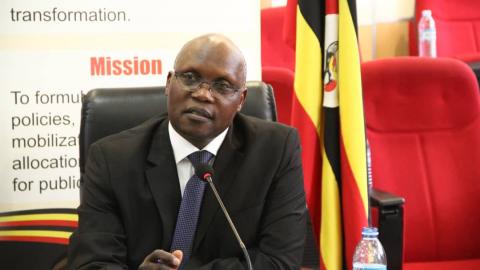Minister of Finance, Planning and Economic Development has Launched the National Budget Month For the Financial Year (FY) 2019/20.
The ministry indicated that the National Budget for the Financial Year 2019/2020 will mainly focus on interventions that are aimed at increasing the country’s Gross Domestic Product (GDP) growth rate and ensuring its inclusive.
The State Minister for Finance In charge of General Duties Gabriel Ajedra says that some of the interventions include, enhancing agricultural production, lowering the cost of credit, increasing opportunities for youth employment and social economic inclusion as well as improving governance and security among others.
Over the years, Government has engaged in activities aimed at promoting budget transparency through increased citizens’ interactions and engagements on issues of the budget for example through publications such as the Citizens’ Guide to the Budget, Budget Transparency Initiatives including platforms like the Budget Toll Free Hotline, Call Centre and Ministry websites, the Barazas by the Office of the Prime Minister and the decision by Cabinet to explain policy issues through the Media.
The objective of these initiatives is to increase citizen’s participation in the development of their country, through paying taxes and monitoring the use of public resources in the delivery of public services. These initiatives have been instrumental in disseminating information and obtaining feedback.
In the spirit of budget transparency, the Ministry held its first ever Budget Week for FY 2018/19 in June 2018. The purpose of the Budget Week FY2018/19 was to articulate the services that the Government offers and to increase publicity for the National Budget.
Implementation of the Budget Week FY2018/19 was a success, and the feedback obtained was that the event should be held annually. Preparations to hold the same activity for the FY2019/20 Budget have therefore commenced, and the activity has been renamed The National Budget Month FY2019/20.
This Ministry, is therefore scheduled to hold the National Budget Month FY 2019/20 whose objectives are to increase buy-in and support for Government programs, improve accountability and service delivery. However, before I launch the National Budget Month FY2019/20, allow me, ladies and gentlemen, to provide you with a few highlights on the state of the economy for FY 2018/19, budget performance for FY 2018/19 and the budget strategy for FY 2019/20 which was presented to Parliament on 28th March, 2019.
State of the Economy
The economy has recovered from the low growth rate experienced two years ago. Based on the robust performance in the first half of FY2018/19, the economy is expected to grow faster than earlier projected and as a result GDP growth rate for the financial year 2018/19 has been revised to 6.3% from 6.0%. This implies that the size of the economy will increase to Ushs. 110,024 Billion in FY2018/19 up from Ushs. 100,531 Billion in FY2017/18, in nominal terms.
The main drivers of growth in FY2018/19 include manufacturing, private construction, public sector investments in infrastructure, recovery in agriculture and services, regional trade, tourism, ICT and financial services. All these achievements were supported by the prevailing peace and security.
Revenue Performance
April revenue collections amounted to Shs. 1,293.71 billion against a target of Shs. 1,288.05 billion registering a surplus of Shs. 5.65 billion. Cumulatively, overall tax and Non-Tax Revenue collections for the period July 2018 to April 2019 amounted to Shs. 13,463.56 billion against the target of Shs. 13,101.87 billion registering a surplus of Shs. 361.69 billion and growth in revenue collections of 17.2% (Shs. 1,974 billion) compared to the same period FY 2017/18.
Expenditure Performance
The total Government of Uganda (GoU) budget for Financial Year 2018/19 is Ushs 23,904.74 billion. Out of this, 24,799.17 billion has been released, which represents a release rate of 105.7% of the approved GoU Budget.
Debt Sustainability
Uganda’s debt remains sustainable in the medium to long term. As of June 2018, debt was at 41.5% of GDP in nominal terms well below the threshold of 50% Debt to GDP ratio contained in the Charter for Fiscal Responsibility and the East African Community (EAC) Monetary Union Protocol. Government will continue to exercise caution while taking on new debt after the implementation of the flagship projects like; the power generation plants at Isimba & Karuma, the development of Kabaale International Airport in Hoima and the construction of Entebbe Express High Way, among others.
Highlights of the Budget Strategy FY 2019/20
For FY 2019/20, our growth strategy focuses on interventions aimed at increasing our GDP growth rate and ensuring that it is inclusive. Therefore, the strategy focuses on interventions aimed at:-
- Enhancing agriculture production, productivity and agro-processing;
- Investment in physical and social infrastructure to reduce the cost of doing business, facilitate trade and export, tourism and improve social service delivery;
iii. Industrialization to speed up economic transformation;
- Lowering the cost of credit;
- Increasing opportunities for youth employment and socioeconomic inclusion;
- Enhancing environmental protection and mitigating the effects of climate change; and,
vii. Improving governance and security.





















